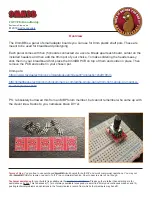
When a software breakpoint instruction is executed, the processor initiates a
breakpoint-acknowledge cycle. This cycle signals the start of an entry into the
monitor. From this point on, stacking and the vector fetch procede the same as for
a break entry. Unlike the interrupt-acknowledge cycle, the
breakpoint-acknowledge cycle is shown to the target system.
tsto any
tg stat=11xxxxxxxx1x000xy
t
r 8
Line addr,H 68040 Mnemonic
----- -------- ------------------------------------------
-4 00000008 $484F0000 sprog long read <-bkpt fetch
-3 0000000c $000BADAD sprog long read
-2 00000010 $000BADAD sprog long read
-1 00000014 $00000000 sprog long read
0 00000000 $41------ bkpt ack (buserror) <-acknowledge
1 000000ee $----0010 sdata word write <-stack format
2 000000ea $----0000 sdata word write <-stack PC high
3 000000ec $0008---- sdata word write <-stack PC low
4 00000010 $00000690 sdata long read <-vector fetch
5 000000e8 $2700---- sdata word write <-stack SR
6 00000690 $11FC0004 mon sprog long read <-monitor
7 00000694 $01186000 mon sprog long read
The only unique portion of a breakpoint entry is the breakpoint-acknowledge cycle
so any problems that you see will probably be related to this cycle. Because the
emulator internally responds to this cycle, it is not necessary for the target system to
respond to it. If the target system does respond to this cycle with any wait states,
the emulator may become out of sync with the target system because the emulator
terminates this cycle immediately. If this were to cause a problem, it would show
up on the cycle immediately following the breakpoint-acknowledge cycle.
Chapter 18: Connecting the Emulator to a Target System
Installing Emulator Features
647
Summary of Contents for 64783A
Page 30: ...xxx ...
Page 31: ...Part 1 Quick Start Guide 1 ...
Page 33: ...1 Getting Started 3 ...
Page 70: ...40 ...
Page 75: ...Part 2 Using The Emulator 45 ...
Page 140: ...110 ...
Page 141: ...4 Using the Emulator How to control the processor and view system resources 111 ...
Page 227: ...5 Using the Emulation Bus Analyzer How to record program execution in real time 197 ...
Page 290: ...260 ...
Page 331: ...8 Configuring the Emulator 301 ...
Page 382: ...352 ...
Page 383: ...9 Solving Problems What to do when the emulator doesn t behave as expected 353 ...
Page 397: ...Part 3 Reference 367 ...
Page 399: ...10 Using Memory Management Understanding logical and physical emulation and analysis 369 ...
Page 429: ...11 Emulator Commands The command syntax reference for the emulator softkey interface 399 ...
Page 443: ...copy Chapter 11 Emulator Commands copy 413 ...
Page 451: ...display Chapter 11 Emulator Commands display 421 ...
Page 457: ...DISPLAY MEMORY Chapter 11 Emulator Commands DISPLAY MEMORY 427 ...
Page 461: ...DISPLAY MMU Chapter 11 Emulator Commands DISPLAY MMU 431 ...
Page 464: ...DISPLAY TRACE Chapter 11 Emulator Commands DISPLAY TRACE 434 ...
Page 480: ...modify Chapter 11 Emulator Commands modify 450 ...
Page 501: ...set Chapter 11 Emulator Commands set 471 ...
Page 514: ... SYMB Chapter 11 Emulator Commands SYMB 484 ...
Page 582: ...552 ...
Page 583: ...13 Setting X Resources 553 ...
Page 598: ...568 ...
Page 606: ...576 ...
Page 613: ...16 Specifications and Characteristics 583 ...
Page 627: ...Part 4 Concept Guide 597 ...
Page 629: ...17 X Resources and the Graphical User Interface 599 ...
Page 639: ...Part 5 Installation and Service Guide 609 ...
Page 697: ...19 Installation and Service 667 ...
Page 746: ...Chapter 19 Installation and Service Verifying the Installation 716 ...
Page 755: ...20 Installing Updating Emulator Firmware 725 ...
Page 762: ...732 ...
Page 778: ...748 ...
Page 810: ...X server 554 604 X Window System 54 Index 780 ...
















































